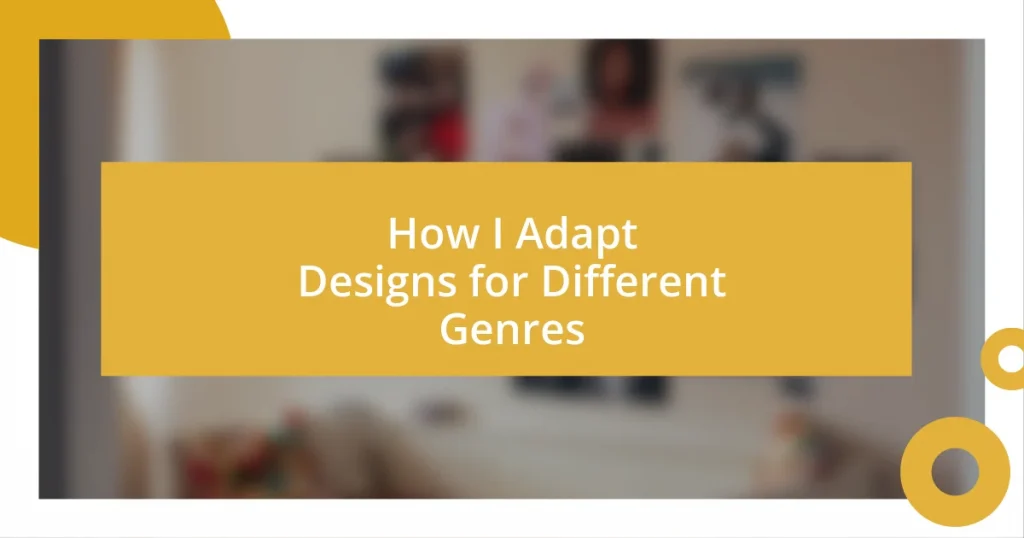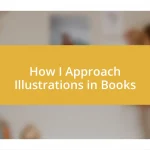Key takeaways:
- Understanding different design genres is crucial for evoking specific emotions and meeting client expectations, influencing overall brand impact.
- Analyzing the target audience’s needs and incorporating their feedback enhances design effectiveness, boosting user engagement and satisfaction.
- Documenting design adjustments and personal reflections allows for continuous learning and improvement, providing valuable insights for future projects.

Understanding Different Design Genres
Understanding different design genres is essential for creating visually compelling work. Each genre has unique elements that evoke specific feelings and convey distinct messages. For instance, I’ve often found that when I design for a sleek tech product, I lean towards minimalism—clean lines and a muted color palette—because it communicates innovation and cutting-edge functionality. Doesn’t it amaze you how a simple choice in color can completely shift the mood of a design?
Then there’s the world of children’s book illustration, where my approach flips entirely. I recall a project where playful, vibrant colors and whimsical fonts drew inspiration from the innocence and excitement of childhood. This genre demanded a warmth and energy that was almost palpable; I wanted to ignite that sense of wonder in every page. How does one evoke joy through design? I believe it lies in tapping into the emotions specific to each genre, like nostalgia in retro designs or elegance in luxury branding.
Moreover, understanding design genres helps me navigate client expectations more effectively. For example, when working on a corporate identity, I realize how vital it is to project professionalism and trustworthiness. I’ve discovered that a balance of classic elements with modern touches often resonates best with corporate clients. Isn’t it fascinating how each design choice can either build or break a brand’s reputation? Through this exploration, I’ve learned that deep understanding of genre shapes not just aesthetic value, but also the impact of the design itself.

Analyzing Target Audience Needs
Analyzing the target audience’s needs is like peering into a collective psyche. When I dive into a project, one of my first steps is to research the audience—who they are, what they like, and how they interact with designs. I remember designing a campaign for a youth-oriented brand, and I immersed myself in their digital environment, engaging with influencers they admired. By doing this, I grasped not just their preferences but also the cultural nuances that mattered to them. Isn’t it incredible how understanding your audience unleashes the creative process?
I often find that analyzing needs goes hand-in-hand with empathy. For instance, when designing for an elderly demographic, I focus on readability—larger fonts and high-contrast colors became crucial. There was a moment during one project when I realized that something as simple as font size could impact accessibility. Seeing a client’s eyes light up as they understood this helped me appreciate the responsibility we have as designers. How can we not feel a deep connection to our work when we know it enhances someone’s experience?
Finally, I can’t stress enough the importance of testing designs with real users. This step opens a dialogue that often reveals insights I might not have considered. I recall conducting user interviews for a mobile app that aimed to simplify budgeting. The feedback helped us adjust features to truly align with users’ needs, resulting in a more intuitive design. This iterative process solidifies my belief that involving the target audience in the design journey not only refines the output but also enriches my understanding of their world.
| Aspect | Youth-Oriented Design |
|---|---|
| Audience Needs | Trend awareness, cultural relevance |
| Design Elements | Bright colors, bold typography, dynamic layouts |
| Feedback Focus | Engagement with platforms and media |

Researching Genre-Specific Trends
Researching genre-specific trends serves as the backbone of my design process. When I start exploring a new genre, I dive deep into current visual styles and cultural cues that resonate with the target audience. I remember a time when I was preparing a design for an indie music festival. By scouring social media platforms, blogs, and even music streaming sites, I was able to capture the local aesthetic—a fusion of vintage vibes and modern elements. This immersive approach doesn’t just inform my designs; it makes me feel more connected to the audience I’m trying to reach.
To truly grasp genre-specific trends, I often focus on the visual language that defines the genre. Here are some key components I always consider:
- Color palettes: What colors are dominating the space? Are they vibrant, muted, or perhaps monochromatic?
- Typography: Do certain fonts resonate better with this genre? Are they playful, bold, or elegant?
- Imagery: What types of images and graphics are prevalent? Are they abstract, realistic, or illustrative?
- Cultural references: Are there particular memes, symbols, or historical elements that capture the essence?
- User interaction: How do users engage with design in this genre? Are there specific features that enhance the experience?
Understanding these nuances empowers me to craft designs that not only look great but also resonate on a deeper emotional level. Each piece feels like a small puzzle I solve to reflect the soul of the genre—creating something that truly speaks to people.

Developing Flexible Design Principles
When I think about developing flexible design principles, I realize it’s all about adaptability. A memorable project for me was designing a promotional campaign for a gourmet food festival. We had to shift our design language halfway through based on feedback about the target audience’s differing tastes. This experience highlighted how being open to change can lead to richer outcomes. Have you ever felt that pivot in direction transformed a project for the better?
I’ve found that setting foundational guidelines is crucial, yet allowing room for experimentation can breathe life into those principles. For instance, while working on an eco-friendly product line, I laid down basic color schemes and font choices to maintain brand consistency. Yet, spontaneous choices—like including earthy textures and hand-drawn elements—added a level of authenticity that simply resonated more with our environmentally conscious audience. Doesn’t this blend of structure and creativity ignite a unique energy in designs?
Moreover, I often remind myself that collaboration fosters flexibility in design principles. I remember a time during a multi-disciplinary project where feedback sessions included not just designers, but also marketing and tech teams. The cross-pollination of ideas led to unexpected creative solutions that improved the overall design coherence. It makes me wonder—how much more perspective can we gain by inviting diverse voices to the table? Embracing flexibility in design allows us to create truly impactful and memorable experiences.

Adapting Visual Elements for Genres
When it comes to adapting visual elements for different genres, I often start with color palettes—it’s fascinating how a simple color shift can completely alter the mood. For instance, while designing for a horror film festival, I leaned heavily on dark reds and blacks to create an unsettling vibe. I vividly remember the moment I incorporated a splash of neon green; it added an unexpected twist that felt eerily electric—like the thrill of a jump scare. Have you ever noticed how colors evoke emotions?
Typography is another visual element I constantly adjust for genre-specific needs. While working on a design for a whimsical children’s book, I gravitated toward playful, rounded fonts that felt inviting and friendly. I still recall the delighted feedback from parents who said the typography alone captured their children’s imaginations. Doesn’t it amaze you how the right font can convey a narrative all on its own?
Imagery is perhaps the most telling aspect of genre adaptation. I once had the opportunity to design artwork for a classic literature-themed gala. Instead of the typical stock photos, I opted for vintage illustrations that resonated with the essence of the authors we were celebrating. The response was overwhelmingly positive, with attendees expressing how the visuals transported them back in time. Isn’t it incredible how the right imagery can create an entire atmosphere?

Testing and Iterating on Designs
Testing designs is a crucial phase where intuition meets feedback. I recall a particular project where I had developed a series of website mockups for a tech startup. After conducting user testing sessions, I received surprising comments about the navigation structure; users found it counterintuitive. I remember feeling a mix of frustration and relief—it was a moment that underscored the importance of real-world testing. Isn’t it interesting how fresh eyes can reveal insights we might overlook?
Iterating based on testing results is where the magic happens. For instance, I once worked on a mobile app redesign where user feedback highlighted that our color contrast was hard on the eyes. By adjusting the contrast and refining the typography, we not only improved readability but saw user satisfaction scores significantly rise. Each iteration felt like peeling back layers to uncover a more polished final product. Have you ever experienced that eureka moment after making a small tweak?
Moreover, the iterative process often encourages creative problem-solving. During a project for an educational platform, we faced challenges with engagement metrics. After testing, it seemed users preferred interactive elements over static content. We quickly adapted by incorporating quizzes and gamified designs. Witnessing the immediate boost in user engagement was incredibly gratifying. It makes me wonder—how often do we overlook the simplest changes that can make a world of difference?

Documenting Design Adjustments and Learnings
Documenting design adjustments and learnings is an invaluable practice that helps me refine my craft. I try to maintain a design journal where I record each iteration along with the reasoning behind changes I made. I remember the time I struggled to decide on a layout for a documentary series; jotting down my thought process not only clarified my direction but also revealed patterns I hadn’t noticed before. Do you keep track of your creative evolutions?
Reflecting on past projects, I find that the documentation serves as a treasure trove of inspiration. For instance, I once faced challenges with a branding project that just wasn’t resonating. In going back through my notes, I discovered a previously discarded design idea that perfectly addressed the brand’s core message. It was a lightbulb moment that reminded me of how past learnings can lead to present solutions. Isn’t it surprising how often we overlook our own past insights while chasing new ones?
The emotional aspect of this documentation is profound. I often note my feelings—like anxiety during tight deadlines or joy when a design finally aligns just right. This reflection adds depth to my future work; I can identify what truly drives my creativity. For example, after completing a character design for a fantasy game, my elation at seeing feedback from players brought clarity to what resonates emotionally with audiences. Have you ever considered how your feelings and experiences shape your design choices?















